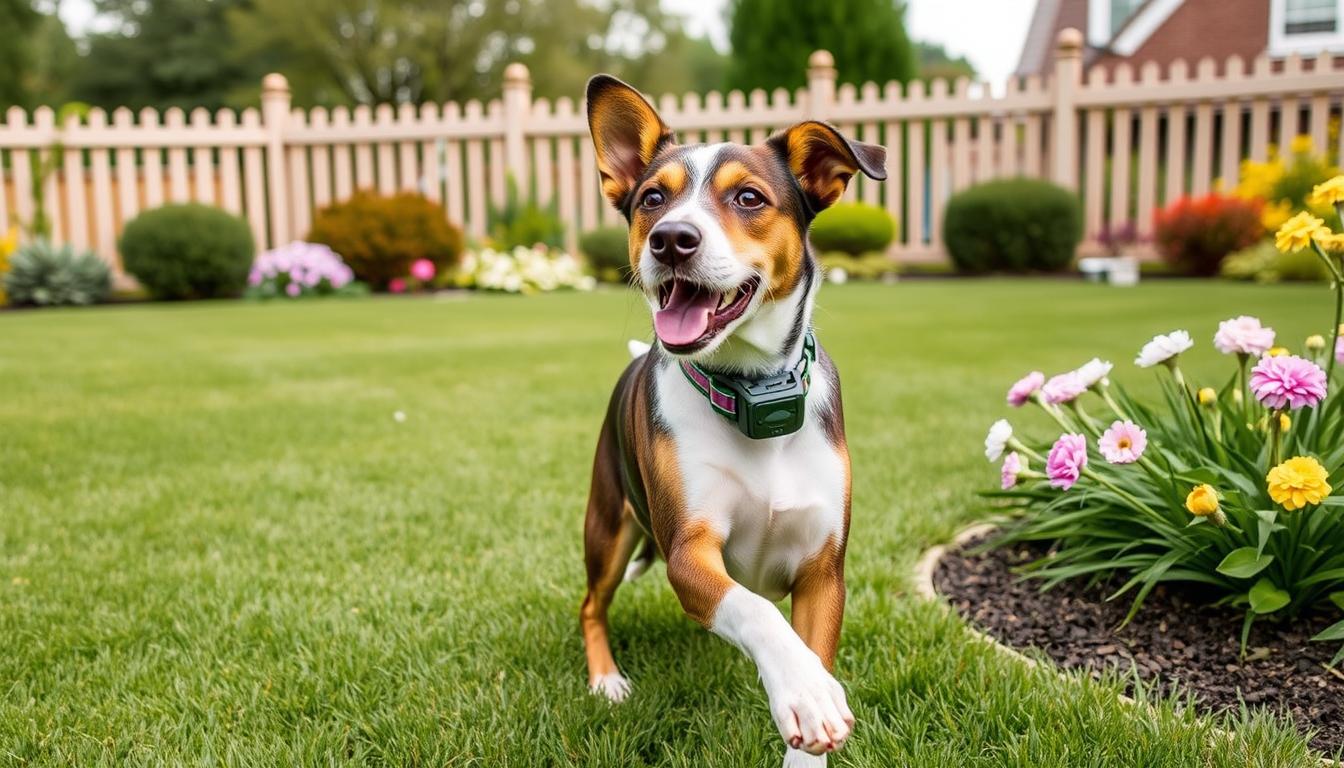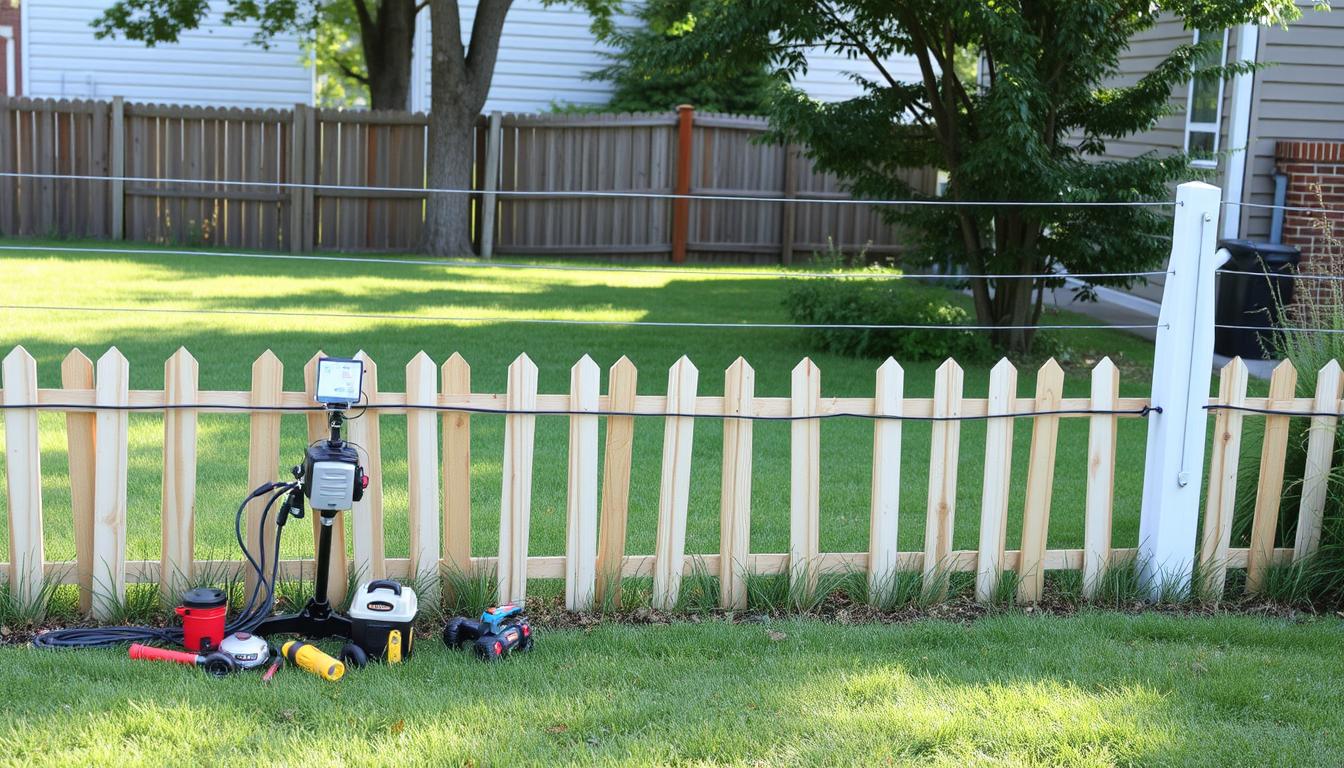Keeping your dog safe without physical barriers has become increasingly easier with the advancements in invisible dog fence technology. Modern solutions offer a range of choices, from traditional buried wire systems to cutting-edge GPS-based containment systems like the Halo Collar and SpotOn GPS Fence.
These innovative fences provide freedom for your dog to roam within set boundaries while maintaining safety. The latest technology allows for customizable correction methods, including sound, vibration, and static feedback, to suit different dogs’ temperaments and training needs.
With so many options available, choosing the right invisible dog fence can be overwhelming. This comprehensive guide will explore the various solutions, helping you understand which might be best for your specific situation and property.
Key Takeaways
- Modern invisible dog fences offer a range of technologies, including GPS and buried wire systems.
- Customizable correction methods allow for tailored training and safety.
- Invisible fences provide freedom for dogs to roam within set boundaries.
- Advanced technology enhances reliability and safety for pets.
- Choosing the right fence depends on your specific situation and property.
- Hybrid options combine multiple technologies for enhanced effectiveness.
Understanding Modern Invisible Dog Fence Technology
Invisible dog fencing has come a long way, from simple buried wire systems to advanced GPS-based solutions. Modern invisible dog fence technology has evolved to provide pet owners with more flexibility, effectiveness, and ease of use.
How Invisible Fences Have Evolved
The invisible fence technology has transformed significantly over the years. Early systems relied on buried boundary wires that transmitted signals to a dog’s collar, creating a static correction zone. In contrast, modern GPS-based systems use satellite positioning to create virtual boundaries that can be set up and modified through smartphone applications.
- Evolution from basic radio frequency systems to sophisticated GPS-enabled containment solutions.
- Elimination of physical wires with the advent of GPS-based systems.
Traditional vs. GPS-Based Systems
When comparing traditional buried wire fence systems to GPS-based ones, several differences emerge. Traditional systems offer consistent boundary recognition but require physical installation. On the other hand, GPS-based systems provide flexibility and don’t require physical installation, but may have accuracy limitations in certain environments.
- Traditional systems: consistent boundary recognition, physical installation required.
- GPS-based systems: flexible, no physical installation, potential accuracy limitations.
Benefits of Using Invisible Dog Fence Options You Didn't Know You Needed
Invisible dog fences offer a range of benefits that can enhance your dog’s freedom and safety. These systems are designed to provide your dog with the ability to roam within designated boundaries while protecting them from potential hazards.
Freedom and Safety for Your Dog
Invisible dog fences give your dog the freedom to explore your property while keeping them safe from roads and hazardous areas. This balance is crucial for your dog’s well-being and your peace of mind.
Aesthetic Advantages Over Physical Fences
Unlike traditional fences, invisible dog fences preserve your property‘s aesthetic appeal. They eliminate the need for physical barriers that can detract from your home’s appearance.
Flexibility and Portability
Modern invisible dog fences offer flexibility and portability. GPS-based systems like SpotOn and Halo allow you to create custom boundaries for your yard, regardless of its size or shape.
| Feature | Invisible Dog Fences | Traditional Fences |
|---|---|---|
| Aesthetic Appeal | Preserves property appearance | Can detract from property appearance |
| Flexibility | Customizable boundaries | Fixed boundaries |
| Portability | Portable with GPS-based systems | Not portable |
GPS-Based Invisible Fence Systems
GPS-based invisible fence systems are revolutionizing the way we keep our dogs safe and contained. These systems utilize satellite positioning technology to create virtual boundaries, eliminating the need for physical wires or markers.
How GPS Dog Fences Work
GPS dog fences operate by using satellite positioning to create virtual boundaries stored in the collar’s memory. They connect to multiple global navigation satellite systems (GNSS) for enhanced accuracy, with some accessing up to 6 different satellite constellations.
Advantages Over Traditional Buried Wire Systems
Unlike traditional systems, GPS fences can be set up in minutes via smartphone apps, allowing for instant creation, modification, or disabling of boundaries. The major advantages include portability, flexibility, and the ability to cover larger areas.
| Feature | GPS-Based Systems | Traditional Buried Wire Systems |
|---|---|---|
| Setup Time | Minutes | Hours/Days |
| Flexibility | High | Low |
| Coverage Area | Large | Limited |
Limitations to Consider
While GPS-based systems offer many advantages, they can be affected by heavy tree cover or tall buildings, potentially causing accuracy variations. However, advanced models like SpotOn have largely overcome these challenges with dual-feed antenna systems.
Halo Collar 4: Next-Generation GPS Containment
The Halo Collar 4 represents a significant advancement in GPS containment technology for dogs. This next-generation collar is designed to provide dog owners with a flexible, reliable, and effective way to keep their pets safe within designated boundaries.
Key Features and Technology
The Halo Collar 4 boasts several key features that make it stand out. Its dual-frequency GPS technology ensures accuracy within 1.4 feet of your dog’s true outdoor location.
Dual-Frequency GPS and Battery Life
The collar offers improved battery life of 30+ hours on a single charge, making it suitable for all-day use. This means you can enjoy freedom with your dog, knowing they’re safe and contained within your set boundaries.
Customizable Correction Methods
Halo’s system allows for customizable correction methods, including sound, vibration patterns, and adjustable static levels tailored to your dog’s temperament and training needs.
Pros and Cons of the Halo System
The Halo Collar 4 offers several advantages, including real-time location tracking and the ability to create virtual boundaries of any size or shape. However, it requires a subscription plan for full functionality, and the initial cost is higher than traditional invisible dog fences. Despite these drawbacks, the Halo Collar 4 remains a top choice for many dog owners due to its advanced features and flexibility, making it a great option for your yard or larger areas.
SpotOn GPS Fence: American-Made Reliability

For pet owners seeking a reliable GPS dog fence, SpotOn offers an American-made solution. Manufactured in Manchester, NH, SpotOn GPS Fence combines quality craftsmanship with advanced technology.
Standout Features and Technology
The SpotOn system boasts a dual-feed antenna, ensuring consistent boundary alerts even in challenging environments. This feature, combined with the ability to create custom fences from ½ acre to 100,000 acres, makes it highly versatile.
Dual-Feed Antenna System
The dual-feed antenna technology is independently tested to provide boundary alerts 100% of the time, outperforming other GPS systems in areas with heavy tree cover.
Subscription Options and Tracking
SpotOn offers basic GPS fence functionality without a subscription, with optional plans for real-time location tracking and alerts, enhancing the system’s flexibility.
Pros and Cons of the SpotOn System
The SpotOn GPS Fence offers flexibility and reliability, justifying its investment for many users. While the initial cost is higher than some traditional options, its performance and lack of hardware installation requirements make it a valuable choice.
Traditional Invisible Fence Systems

For pet owners seeking reliable dog containment, traditional invisible fence systems remain a popular choice. These systems have been refined over 50 years of experience and are backed by veterinarian and animal behaviorist approval.
How Buried Wire Systems Work
Traditional invisible fence systems utilize buried boundary wires that create a radio frequency field. When your dog approaches the established boundaries, their collar receives a signal, triggering a correction to keep them safe within your home.
Professional Installation and Training
Companies like Invisible Fence® offer professional installation and comprehensive training programs. Trained technicians customize the system to your property’s layout, ensuring proper wire placement and signal consistency. Professional trainers work with you and your dog to ensure a proper understanding of boundaries.
Pros and Cons of Traditional Systems
The main advantages of traditional systems include consistent boundary recognition, one-time setup with minimal maintenance, and proven reliability. However, potential drawbacks include the necessity for physical installation, limited flexibility for boundary changes, and the inability to easily transport the system.
Choosing the Right Invisible Fence for Your Situation
To ensure your dog’s safety and happiness, it’s essential to choose an invisible fence that suits your specific situation. The decision involves evaluating several critical factors to determine the most appropriate system for your property and pet.
Property Size and Layout Considerations
Property size and layout play a crucial role in selecting an invisible fence. Traditional buried wire systems are often cost-effective for standard residential lots, while GPS-based systems excel in larger or irregularly shaped properties. For instance, SpotOn GPS Fence works effectively from ½ acre to 100,000 acres, and Halo Collar covers areas from 900 sq ft to 1,200 sq miles. Consider your property’s unique features, such as landscaping and existing underground utilities, to ensure optimal performance.
Dog Size, Breed, and Temperament Factors
Your dog’s size, breed, and temperament significantly impact the choice of an invisible fence. High-energy breeds or dogs with strong prey drives may require more robust containment solutions with customizable correction levels. For example, Halo Collar has been successfully used with over 350 breeds, offering flexibility for various dog temperaments. Assessing your dog’s specific needs will help you choose a system that provides both safety and effectiveness.
Budget and Long-Term Cost Analysis
Budget considerations should encompass not only the initial purchase price but also potential installation costs for traditional systems, subscription fees for GPS options, and long-term maintenance expenses. GPS-based systems typically have higher upfront costs but offer greater flexibility, potentially lowering lifetime costs if you move frequently. In contrast, traditional systems may be more economical for those planning to stay in one location long-term. Evaluating these factors will help you make an informed decision that balances your budget with your dog’s needs.
Setting Up and Training Your Dog with an Invisible Fence
The key to a successful invisible fence lies in its setup and training process, which varies depending on whether you choose a GPS-based or traditional system. Understanding these differences is crucial for effective implementation.
Initial Setup Process
Setting up an invisible fence system begins with the initial configuration. For GPS-based systems like Halo and SpotOn, this process is typically done through smartphone apps, allowing you to define boundaries and adjust settings according to your dog’s temperament. In contrast, traditional systems require professional installation, involving the physical laying of wire around your yard.
Training Methods and Timeline
Effective training is critical for the success of an invisible fence. Most systems recommend a phased training approach, starting with boundary awareness and gradually introducing correction signals. The training period typically lasts 2-3 weeks, with daily sessions of 10-15 minutes. Proper collar fit is essential, and indicators of successful training include your dog responding to warning signals and respecting boundaries even when faced with distractions.
| Training Aspect | GPS-Based Systems | Traditional Systems |
|---|---|---|
| Setup Method | Smartphone App | Professional Installation |
| Training Duration | 2-3 weeks | 2-3 weeks |
| Training Approach | Phased, with DIY guides | Phased, with professional training |
By understanding the setup and training requirements of your chosen invisible fence system, you can ensure a safe and effective experience for your dog.
Conclusion: Creating a Safe, Boundary-Free Environment for Your Dog
With the right invisible fence, you can give your dog the freedom to roam while keeping them safe. Modern systems like Halo Collar and SpotOn GPS Fence provide peace of mind through real-time tracking and customizable boundaries that work across various environments, from small yards to properties over 100,000 acres.
This technology has revolutionized the way we balance our dogs’ need for freedom with our desire to keep them safe, offering solutions that work for virtually any property size or dog temperament, thus improving your dog’s quality of life.


